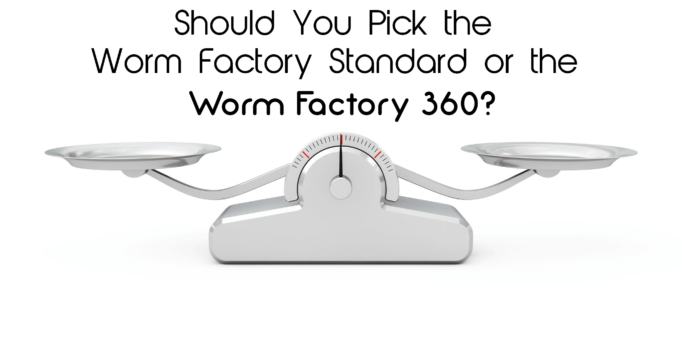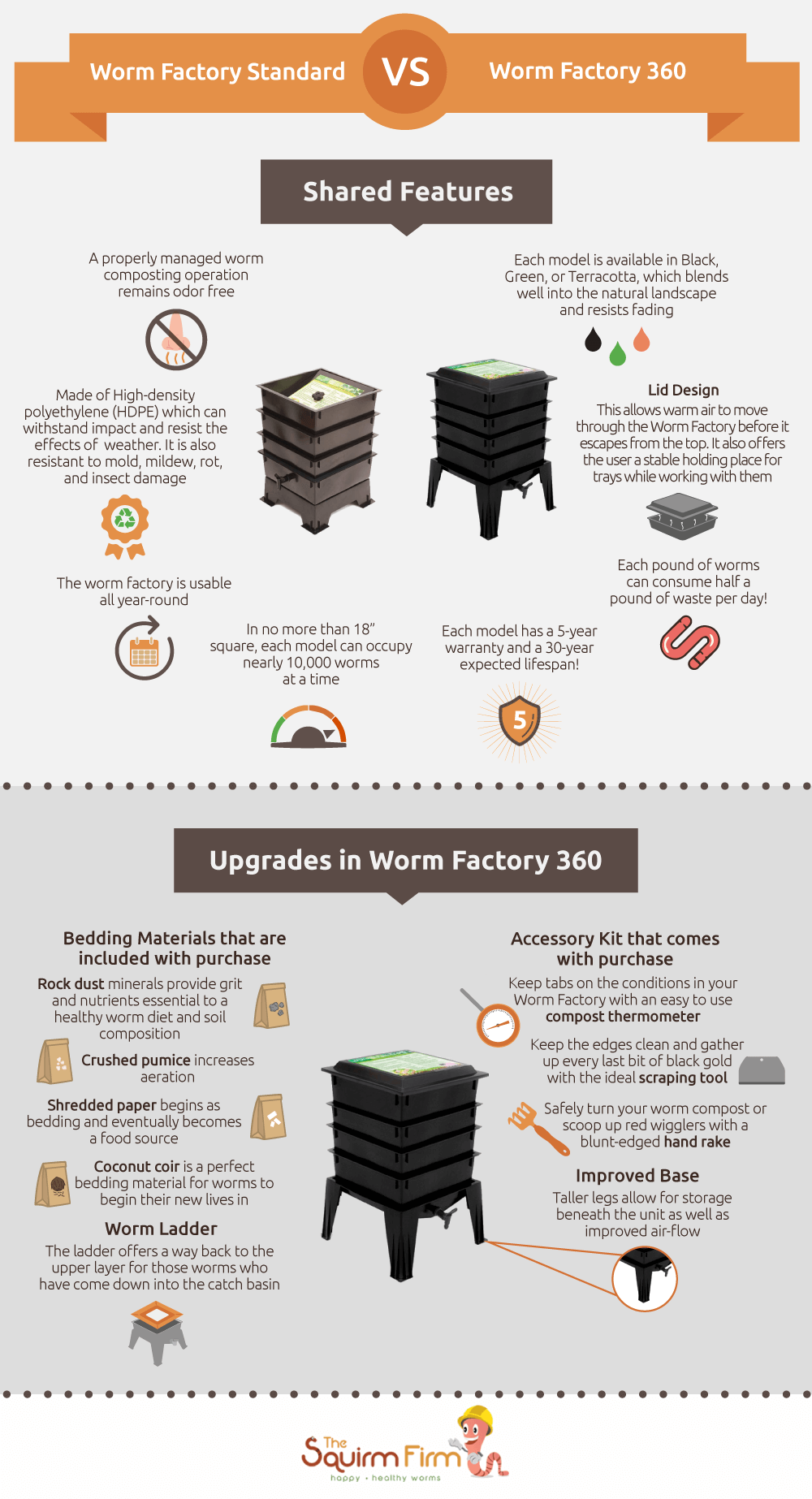Decisions, decisions!
Comparison shopping is a real nightmare for some and a great adventure for others. You know how it goes, one of you pours over Consumer Reports analyzing reviews before ever making a purchase–while the other trusts a buddy’s word above all else.
This article is meant to serve both types. If you are the grab-n-go, hear it from a buddy type, I’ll just lay it out there in simple terms to show how the Worm Factory 360 and its predecessor, the Worm Factory Standard, compare. But for those who came to study, I also have a complete breakdown of every single feature and benefit unique or common to each model.
If you are new to worm composting, welcome. If worm composting is already your favorite past-time, thanks for squirming up alongside us! You’ll especially appreciate learning how the Worm Factory solves problems common to other worm composting methods.
Shared Features of the Worm Factory Standard and the Worm Factory 360
The Worm Factory takes everything great about worm composting then raises the bar. Both the Standard and 360 models are packed with features and benefits that make vermicomposting a new kind of luxury.
Compact Footprint with Large Capacity
In no more than 18” square, each model can occupy nearly 10,000 worms at a time. The option to add extra trays offers adaptability and greater capacity as needed.
Lid Design
A prime component of the thermo-siphoning air-flow improvement lies in the design of the domed lid which allows warm air to move through the composter before it escapes from the top.
A second benefit to the new lid design is how it offers the user a stable holding place for trays while working with them.
Made of High-Quality Recycled Plastic
High-density polyethylene (HDPE) is a very lightweight but durable material made to withstand impact and resist the effects of weather. It is also resistant to mold, mildew, rot, and insect damage. HDPE is why the Worm Factory has a 30-year expected lifespan!
Available in Black, Green, or Terracotta
Who doesn’t like options? Each color blends well into the natural landscape and resists fading.
Usable Year-round
As long as your unit is well-maintained and kept within appropriate temperatures, you need never stop processing waste through your Worm Factory.
Odor-free
A properly managed worm composting operation remains odor free.
Transforms Pounds of Waste into Compost Each Week
Each pound of worms can consume half a pound of waste per day! A Worm Factory in full operation may hold nearly 10,000 worms at a time! That’s a LOT of worm composting!
Instructional Guide
Each Worm Factory comes with both digital access as well as a condensed hard-copy form of the detailed instructions to get your Worm Factory up and running.
Share this image on your site and please include attribution to The Squirm Firm:
Features Unique to the Worm Factory 360
How do you entice new worm farmers and those looking to upgrade their existing Worm Factory arrangements? Make that good product even better, of course!
A few tweaks and extra features were all it took.
From the ground up the Worm Factory 360 outshines the Standard model. In terms of design, adaptability, accessories, and materials, the Worm Factory 360 serves to better enhance the overall user experience.
Improved Base
Taller legs allow for storage beneath the unit as well as improved air-flow.
Worm Ladder
Sometimes, worms seeking a mate, food, or optimal conditions find themselves exploring places they aren’t meant to be. Unfortunately, they often end up as shriveled worms who never found their way home.
Again, the minds that created the Worm Factory Standard and Worm Factory 360 came up with a solid fix. It’s called a worm ladder. Less of a series of rungs than a ramp around the inner perimeter, the ladder offers a way back up for those worms who have come down into the catch basin.
Honestly, I’m not entirely sure this works. I’ve seen my worms slink right up a vertical wall–I think they could easily pull themselves out of the shallow confines of the base even without a ladder. However, even with the ladder in place, at times I still find worms in the base dried out and expired.
The verdict is out on this one.
Accessory Kit
Keep tabs on the conditions in your Worm Factory with a handy and easy to use compost thermometer.
Keep the edges clean and gather up every last bit of black gold with the ideal scraping tool.
Safely turn your worm compost or scoop up red wigglers with a blunt-edged hand rake. It will quickly become your best friend when working with your worms.
Bedding Material
Rock dust minerals provide grit and nutrients essential to a healthy worm diet and soil composition.
Crushed pumice increases aeration.
Shredded paper begins as bedding and eventually becomes a food source.
Coconut coir is a perfect bedding material for worms to begin their new lives in.
Doing Away with Storage Bin Dilemmas
I’m certainly not one to knock the good ol’ storage bin worm farm. In fact, my first pound of worms came hand-delivered in a great big blue Rubbermaid with a fancy bow on top.
Through trial and error that bin served me and a great many worms pretty well for a pretty long time. However, a gal can only handle so much “ew” before looking for ways around some of her worm composting pitfalls.
Poor airflow and drainage meant there were times my poor red wigglers had to seek high ground just to avoid the Lake Stank in their bin. Then there was the flurry of fruit flies that would greet me excitedly at every visit throughout the summer. There were even times when food-science chemistry experiments born of moist stagnant air would turn entire feedings into fuzzy clouds of mold!
Things weren’t exactly glamorous in my worm composting world. But I pushed on through until the fateful day when I decided there had to be a better way.
Truth be told, the straw that broke this camel’s back came from needing a more efficient way to harvest all that black gold. It was straight-up tedious and frustrating getting a storage bin full of vermicompost and worms sorted, dried, sifted, and back into production.
New Generation Worm Farms Solve it All!
I realized that my issues would be there to stay unless I figured out how to manage a closed system much better, or found a much better system.
Sure, I could follow all the “rules” and train myself to be a more worthy worm steward, but I’m a mom, a wife, an employee, and so much more (I say!). It was way easier to just look for something that would streamline the whole process of worm composting from the start.
It took only one quick Internet search to discover the product that takes an entirely different approach to worm composting. I found the Worm Factory Standard and Worm Factory 360.
These innovative tray-method worm composting systems have simply revolutionized vermicomposting. The Worm Factory Standard and Worm Factory 360 provide a way around every frustrating storage-bin worm composting obstacle.
Problem = Solved
Drowned Worms
The ideal storage bin for a worm farm is opaque with holes drilled throughout for air-flow and drainage. Unfortunately, drainage means leakage–and leakage means cleanage. Not my idea of fun.
Thankfully, the clever minds behind the Worm Factory systems devised a way to capture all of that rich leachate (excess moisture filtered through vermicompost) before it’s ever wasted on my floor or left to puddle on my deck. Not to mention, never again would my worms need to swim for their lives to escape drowning in their bin.
The sturdy base doubles as a catch basin fully equipped with a nifty spout for measured pours of the good stuff! Also, stout legs provide a firm foundation, an open area for storage beneath the unit, and even dissuade ants from climbing up into the trays.
One Huge Place Replaced by Uno, Dos, Trays
An average storage bin has a composting surface area limited to about 6 square feet, depending on the model. Along with that, the footprint of a storage bin is roughly equal to its surface area.
That much volume is great for packing away summer clothes but unnecessary for composting worms. Now, I don’t know about yours, but in my house, a worm bin like that takes up a lot of floor space!
So, one of my favorite features of the Worm Factory 360 design is that its footprint is a meer 18” square! What’s more, in full operation the tower stands only 28” tall. It is very easily tucked inconspicuously into small spaces.
Made of recycled plastic, durable grid-bottomed trays offer as much as 10.5 square feet of worm composting surface area per unit. That’s enough space for more than 10,000 worms!
No Way to Go With the Flow
The greatest upgrade of all took on the issues of odor, insufficient drainage, airflow, and harvesting ALL IN ONE!
The solution came by way of each tray’s ¼ inch grid bottom. These thousands of holes provide airflow and drainage between each layer of compost.
“Thermo Siphon Airflow” draws air in through the base. Compost gasses and warm air are siphoned up through the trays and out from under the lid. In comparison, this allows for 10x better circulation than similar models.
Constant airflow prevents anaerobic decomposition in the Worm Factory keeping it smelling earthy rather than awful. Drainage also allows for adequate oxygen throughout the bedding and a healthier environment for all of the worms and beneficial bacteria!
Worms easily climb up and down through the spaces in search of food, a mate, or more optimal conditions. Sensing space to occupy, the worms rapidly reproduce to populate whatever area they have.
No More Hunkered Harvest
My very favorite thing about using a tray style system is how you can prep and complete the black-gold harvest without a hassle.
When a tray seems to be nearing completion you stop adding food to it. The worms will continue to dine on whatever matter remains further processing it into a fine fertilizer.
After a couple of weeks, enticing food is put in the tray above to lure worms up from below. The bottom tray will now be fairly worm free and ready for sifting.
The tray itself is an excellent sifter. Gently shaken back and forth, the vermicompost will fall through the holes to be collected and used as the most natural and nutrient-rich fertilizer available.
What’s Left to be Desired?
Does the Worm Factory seem too good to be true?
If you want to be picky (I can be) you might find just a few things about many worm composting systems, including the Worm Factory, that… take a little extra getting used to.
Like the list of possible side effects drug companies have to publish, I’m happy to give you a little heads up sort of disclaimer. Luckily, none on this list will result in anything as bad as blurred vision, hot flashes, or constipation!
May Attract Flies or Mites
Many common “pests” hitch a ride on the food scraps we feed our worms. To keep these populations in check, freeze scraps before serving. This will kill the eggs before they hatch. A layer of moist newspaper on top of each tray of food and bedding works wonders as well.
Some Parts Unsafe for Children
The spigot, knob, and attachment hardware are small enough to be swallowing or choking hazards for children under 3. Please use caution.
Lid May Warp Over Time
Extreme temperatures may cause plastic to warp. Extreme temperatures will also kill your red wigglers. Please store your Worm Factory out of direct sunlight and where temperatures remain moderate.
Holes Occasionally Clog
Both the spigot and grid bottom rely on open spaces to function properly. Overly wet worm compost becomes mud-like and may end up closing off these holes. Periodically scrape the tray bottoms to loosen caked on bits. If you fear your spigot may be clogged, simply poke through to clear it.
Top Layers Dry Out
Since warm air rises and excess moisture sinks to the bottom, sometimes the uppermost trays need frequent watering to keep the humidity up. The worms will avoid hot, dry areas. A spray bottle helps to water easily and evenly.
Weigh your Options
Carefully considering each of the pros and cons of the Worm Factory models made it really easy for me to take the next step in my worm composting hobby/career. I hope that you too are excited about the potential a Worm Factory has in store for you!
Realistically, I know there are some people who use a Worm Factory but still have a sweet spot for their storage tote worm bins. I get that because I too have some nostalgia for my little blue bin.
Instead of ditching mine, I simply added real estate by splitting my herd and moving half into their own new Worm Factory 360 high rise. If you aren’t yet sure which you’ll prefer, I suggest you do the same and give it a few months’ trial.
Now that you know how the Worm Factory 360 and Worm Factory Standard compare, I’ll bet you’ve already made your mind up as to which worm bin suits you best. I hope this article has helped you come to a well-informed conclusion that you feel confident about. If you are ready to take the next step, come find your favorite among the worm bins offered in our store, where all you need is just a click away.
Happy worm composting!



Do you have any experience with Worm Inns? I also saw a new flow-through version called the Urban Worm Bag that’s coming out in January. I’m intrigued by both.
Thanks for coming to The Squirm Firm to find out more!
There are so many intriguing ways to use worms to transform waste into treasure! I haven’t used either the Worm Inn or the similar Urban Worm Bag but have researched the method they employ. They both rely on the “flow-through” method which is a particularly hands-off approach until it’s time to harvest. As with any other method, the temperature, moisture, pH, and airflow need to be monitored along with keeping a watchful eye on population growth and appropriate feedings. Find out more about which method of worm composting suits you best right here!http://thesquirmfirm.com/popular-worm-composting-methods-suits-best-2/
I haven’t gotten help from posting here, yet. When starting the second bin, do I prepare it just like the first one? Newspaper, coconut stuff, mineral, THEN add green. In my case, I THINK I need to divide and divide again as I put 3 lbs into my first bin. It’s only been a few days and already I see worms climbing to the top of the damp newspaper on top.
Great question! When starting the next layer up in a tray style worm composting system you are able to simply start adding brown and green materials to the level higher. Add moist newspaper on top of that material to keep it moist, dark, and somewhat contained. Your worms will go exploring but should always come back to where the food is at. I suggest you continue to add feedings only to the bottom level if there is room. That way the worms will concentrate their efforts on the lowest tray first. If it’s just too full, go ahead and add food to the level up. Doing great!
what is the lowest temp. the worms will survive? have a unheated sun room what gets down to 32degrees in the winter at night but goes up to 40degrees in the daytime.will they survive or will I have to make arrangements to keep them worm at night?
Hi Jerry, to answer your question, I’ll say that it is POSSIBLE that you would have surviving worms if you have a very large worm compost system that is unlikely to freeze because of the heat of ongoing decomposition, or just that it can retain enough heat not to freeze overnight. It is very likely that at these temperatures you will lose most of your living worms. However, cocoons are likely to survive and therefore give you a new herd once the temperatures rise again. They’ll be much more productive and viable if they can be kept warmer throughout the cold months. Best of luck!